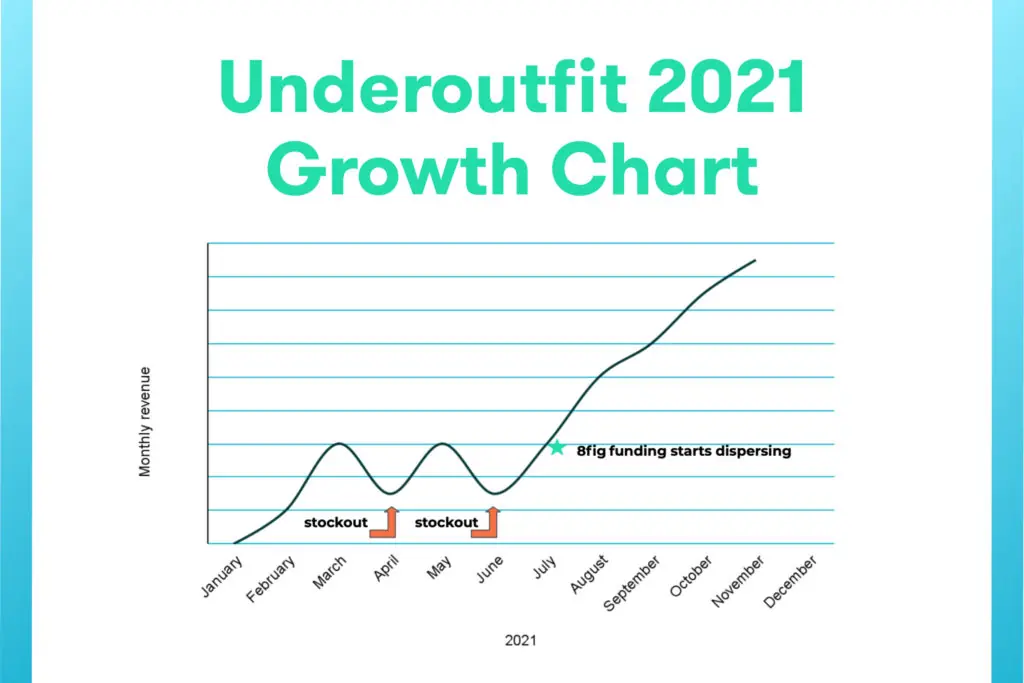Running out of inventory is bad for business, so learning how to prevent stockouts is critical for success. If a product is out of stock in your online store, you’ll lose customers to sellers with available merchandise. It also forces you to issue refunds rather than exchanges on already sold goods, all while overwhelming your customer support with inquiries.
Fund your inventory with 8fig!
And there’s even more bad news if you’re an Amazon seller. Running out of stock leaves a mark on your reliability record, causing you to lose your hard-earned rankings fast.
In this article, we’re going to discuss one of the dirtiest words in eCommerce – stockouts. We’ll dive into what they are, their impact, and how to avoid them, ensuring a profitable year for your business.
What are stockouts?
A stockout occurs when an online seller runs out of inventory and can’t fulfill product demand, and the cost is more significant than you may think. There’s the obvious gross margin loss, but you’ll also incur expenses adjusting your supply chain. For example, there’s the loss of marketing dollars that didn’t produce a sale, fees for expediting replenishment orders, as well as costs associated with backorders, refunds, and canceled orders.
All of these things must be considered when calculating the cost of a stockout. To determine the financial impact on your business, use the following formula.
Cost of a stockout* =
[Number of days out of stock X average units sold per day X price per unit]
+
Cost of consequence
*Source: NLPA.
The cost of consequence includes all of the expenditures associated with adapting your logistics process, but you also need to consider the loss of repeat business and the hit to your reputation.
That lost customer could have become a regular buyer, but now they’re more likely to go to your competitor, who they view as more dependable. Author and Business Coach Kate Zabriskie said, “The customer’s perception is your reality.” Regardless of your intentions, a stockout makes you appear untrustworthy in the eyes of a buyer, harming any sense of brand loyalty.
We’ll ask a few quick questions to better understand your specific business needs. Then, we’ll build a funding plan tailored to your expenses.
Subscribe to the eCommerce newsletter for
top industry insights
Prevent inventory stockouts with these 7 tips
Running out of stock should be avoided at all costs. Fortunately, there are steps you can take to prevent stockouts, keeping inventory moving and your reputation intact.
1. Accurately forecast your supply chain needs
Running your eCommerce store without planning your supply chain is like trying to reach a destination without GPS. It’s possible, but you’re more likely to run into obstacles, ultimately taking longer to achieve your goal.
Within your supply chain, there are numerous steps in which interruptions can occur, causing ripple effects that lead to stockouts.
- If you don’t place a batch order on time or you’re late submitting deposits, you may have to pay fees to expedite your order or be without inventory when you need it.
- If your shipping provider encounters delays, that can lead to low or no stock.
- If your marketing isn’t in alignment with your supply chain, you may generate more business than your inventory can support.
To avoid stockouts and grow your online store, create a supply chain plan based on forecasts that take future demand into account. 8fig has created the Lines Lab so you can get ahead of obstacles. This free technology provides a bird’s eye view, allowing you to plan and adjust to ensure your supply will always meet demand as it ebbs and flows.
2. Order stock in large batches
Ordering batch by batch can feel like living paycheck to paycheck, causing stress and requiring you to juggle cash and inventory. Purchasing smaller batches, while easier to fund through bootstrapping, means you must initiate orders more frequently, opening the door for more obstacles to occur.
Plus, the less stock you have at any given time increases the likelihood of running out.
An accurate forecast and steady cash flow will allow you to order larger batches. And ordering on a quarterly or biannual schedule saves you money per item and gives you more leeway to place reorders before running out of stock.
3. Diversify your suppliers
Even the most reliable of suppliers will experience disruptions, whether it’s a delay from raw material shortages, machinery breakdowns, tariff impacts, or a ship stuck at port.
Rather than waiting for a supply chain snowball to happen before reacting, you should proactively source backup suppliers so you always have someone to call in the event of an emergency.
If you need a quick turnround, partners based in the U.S. can generally get inventory out the door more quickly. While the cost may be higher than overseas manufacturers, it’s valuable to have domestic suppliers to get you out of a bind.
4. Adjust your advertising
Your ad budget should reflect your inventory. While a set it and forget it marketing strategy may be time-saving, it can lead to unnecessary spending, driving traffic to unavailable products.
Align your ad budget to your supply chain. If there’s a delay with a batch or you notice inventory getting low, reallocate ad dollars towards an in-stock product.
You can also take that money designated for marketing and put it into another area of your business to help expedite restocking your items. This money could go towards a more costly domestic supplier or utilizing air freight. Shipping via air, while more expensive, is a quick, short-term solution to a stockout.
5. Automate inventory tracking
The first step in preventing a stockout is knowing how much inventory you have on hand. With the myriad of tasks on your plate to successfully run a business, it’s wise to utilize technology and automate processes and data collection where possible, such as inventory tracking.
There is software available that will keep track of your stock, regardless of where it is in your supply chain. Frequently utilizing barcodes and scanners, the software will track your products from warehouse to delivery, notifying you when stock is low, and it’s time to reorder.
Save time and prevent stockouts by automating your inventory tracking.
6. Invest in safety stock
If you’ve had issues with a particular product selling out, or you anticipate an increase in demand, consider investing in safety stock. Having extra inventory on hand eliminates surprise stockouts; however, you must strike a careful balance when investing in additional merchandise. Overordering will result in cash tied up in inventory sitting in a warehouse. Thoughtful planning based on accurate forecasts will help you invest wisely in extra product.
Another important consideration is whether you have the budget to invest in safety stock. 8fig provides continuous capital aligned to your supply chain, allowing you to purchase additional product, ensuring you always have enough inventory to meet demand.
7. Maintain healthy cash flow to respond to curveballs
Market changes and supply chain disruptions are unavoidable, all of which can lead to stockouts. Responding to these challenges costs money, whether that’s placing a replenishment order or paying additional fees to expedite shipping.
Popular content
View articles
Create a free Growth Plan with 8fig’s AI forecasting software, then tap into our continuous capital to fund your hero product and maintain healthy cash flow.
We understand that eCommerce is a dynamic business, and there are numerous steps in the supply chain that could go amiss, causing a snowball effect that impacts your bottom line. Our Change Request feature lets you stay in control, even when disruptions occur.
If you adjust your Growth Plan, your 8fig capital and remittance schedule will move with it. Have cash on hand to respond to every event and opportunity, preventing stockouts while scaling to reach your full growth potential.
Might also interest you:
Underoutfit’s stockout solution
eCommerce is all about logistics – where is your manufacturer, what’s the cost, how do you get it to the US? I felt good with 8fig as a partner because they understand that part.
Felix Leshno
Co-founder and CXO, Underoutfit
Felix from Underoutfit made the most of the dynamic eCommerce environment and grew his business from $0 to 7-figures in less than a year.
With over 20 years of experience in eCommerce, Felix is well-versed in the industry. During the pandemic, he saw the market opportunity for comfortable, high-quality shapewear consumers could wear comfortably at home and launched Underoutfit in January 2021.
Product started flying off the shelves faster than Underoutfit could stay in stock, causing a negative ripple effect throughout the supply chain.
- Best sellers were out of stock
- Ad campaigns had to stop running
- Customer support was overwhelmed, and the refund rate was increasing
Having the experience and foresight to see where this was going, Felix and his partners began to meet with various financing solutions. Still, he didn’t find anything as adaptable as he needed until a friend introduced him to 8fig.
Felix built an aggressive growth plan for Underoutfit and took on 8fig growth capital. He then ordered a massive shipment just before the ships started stacking up at ports as a result of the supply chain crisis. By making sure every stage of the logistics process was well-funded, Felix and his team at Underoutfit were able to scale sales and achieve incredible results.
Utilizing 8fig capital and his hard-earned business savvy, Felix was able to circumvent the supply chain crisis, maintain enough inventory to meet growing demand, reduce risk, and stay in control.
Prevent stockouts and scale your eCommerce business
Stockouts are costly, impacting your bottom line and reputation. Avoid running out of inventory by following these seven tips:
- Forecast your supply chain needs
- Order stock in large batches
- Diversify your suppliers
- Align your advertising to your supply chain
- Automate inventory tracking
- Invest in safety stock
- Maintain healthy cash flow
We can support you in preventing stockouts with our innovative planning and funding platform.
Set up a free 8fig Growth Plan, receive full access to our supply chain planning software, and apply for capital to fund significant reorders today.
Have article ideas, requests, or collaboration proposals? Reach out to us at editor@8fig.co – we’d love to hear from you.





